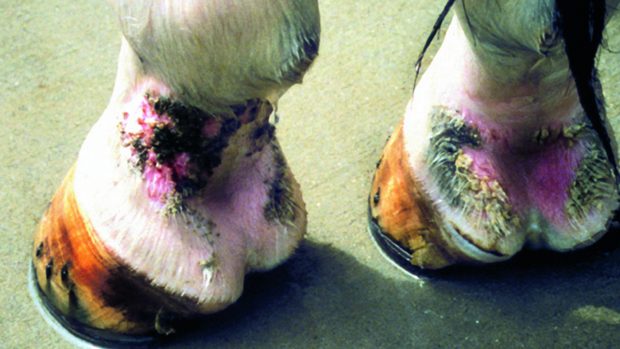You’ve gone to bring in your horse from the field to find that the skin covering his shoulders and belly is a mass of soft, small “doughnut-like” plaques (slightly raised, flat-top swellings), wheals and lumps.
The chances are that this is urticaria and is probably due to hypersensitivity — an allergic response in the skin.
Although its appearance can sometimes be dramatic, urticaria is rarely itchy or painful. In fact, your horse appears blissfully unaware that his skin resembles a lunar landscape, albeit a hairy one!
An urticarial reaction follows exposure to a whole range of possible allergens, including medicines, feed components and inhaled pollens or moulds (see list below). It may be several hours, or longer, between exposure and the skin signs, known as wheals or plaques of oedema, appearing.
Possible causes
Most allergens are taken in by ingestion (food), inhalation (moulds) or injection (vaccinations, fly bites) and spread through the body via the blood. Urticarias can be caused by direct skin contact but are rare.
Immunological urticarias
- Feeds: new hay, barley grain. It is thought that cereal foods are responsible for most cases
- Reactions to medication: penicillin and ‘bute’ are often implicated, but the reaction is often to the preservative rather than the drug itself
- Insect and tick bites and stings
- Bacteria and viruses
- Airborne agents: pollens, dusts chemicals, fungal/mould spores
Non-immunological (physical) urticarias
- Heat or cold
- Heavy exercise (especially in extreme temperatures)
- Physical pressure (whereby a wheal appears after pressure)
- Stress
- Extreme light
Finding the cause
Consider carefully all management aspects of your horse over the previous three or four weeks, especially any recent changes in:
- Medication and drugs, such as vaccinations, worming, antibiotics
- Feeding, such as new hay, supplements, additives or treats
- Physical factors such as extremes of temperature
- Contact factors such as new tack and rugs, rinses and sprays
- Seasonal factors such as insects, pollen and mould
Where possible remove the suspected cause of the reaction from the horse.
Treatment
It is often most practical to manage recurrent or chronic cases of urticaria with steroids, as and when necessary. Antihistamines do not produce good results in horses and can have some very undesirable side effects, most commonly laminitis.
Antigen desensitisation or neutralisation, using a form of “self-vaccination”, is poorly understood and there is very little to support it scientifically. It is costly, with very variable results, but there is some suggestion that it may be of value for some inhaled allergic urticarias.
If all else fails, it is sometimes worth trying a complete change of environment, such as a move to a different yard combined with a totally new diet. This may not be very scientific, but it could be a lot more cost-effective in the long run.
This veterinary feature was first published in Horse & Hound (30 August, ’07)




